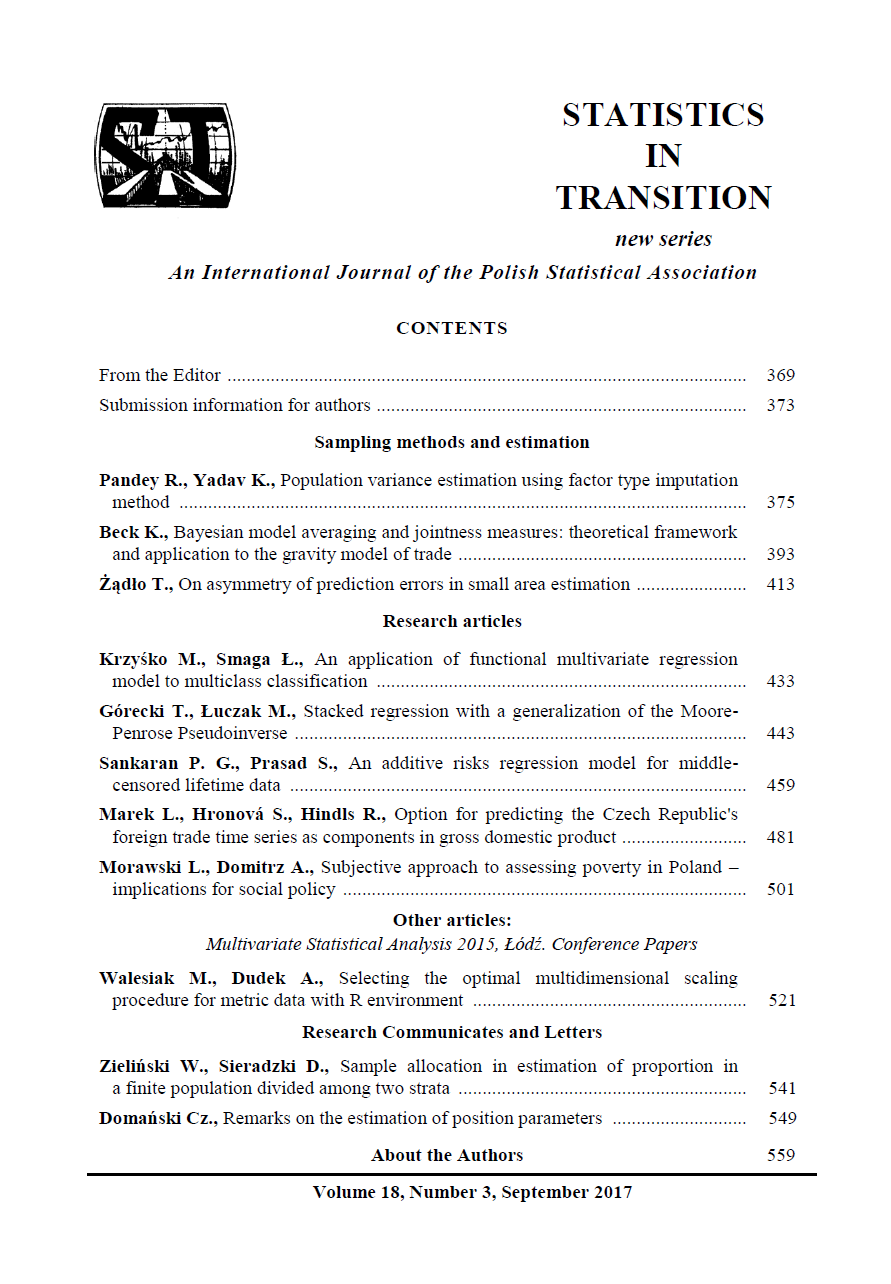ARTICLE
ABSTRACT
In multidimensional scaling (MDS) carried out on the basis of a metric data matrix (interval, ratio), the main decision problems relate to the selection of the method of normalization of the values of the variables, the selection of distance measure and the selection of MDS model. The article proposes a solution that allows choosing the optimal multidimensional scaling procedure according to the normalization methods, distance measures and MDS model applied. The study includes 18 normalization methods, 5 distance measures and 3 types of MDS models (ratio, interval and spline). It uses two criteria for selecting the optimal multidimensional scaling procedure: Kruskal’s Stress-1 fit measure and Hirschman-Herfindahl HHI index calculated based on Stress per point values. The results are illustrated by an empirical example.
KEYWORDS
multidimensional scaling, normalization of variables, distance measures, HHI index, R program
REFERENCES
BORG, I., GROENEN, P. J. F., (2005). Modern Multidimensional Scaling. Theory and Applications, 2nd Edition, Springer Science+Business Media, New York. ISBN: 978-0387-25150-9, URL http://www.springeronline.com/0-387-25150-2.
BORG, I., GROENEN, P. J. F., MAIR, P., (2013). Applied Multidimensional Scaling, Springer, Heidelberg, New York, Dordrecht, London,URL http://dx.doi.org/10.1007/978-3-642-31848-1.
COOPER, L. G., (1983). A review of multidimensional scaling in marketing research, Applied Psychological Measurement, Vol. 7, No. 4, pp. 427–450,URL https://doi.org/10.1177/014662168300700404.
DE LEEUW, J., MAIR, P., (2009). Multidimensional Scaling Using Majorization: SMACOF in R. Journal of Statistical Software, 31 (3), pp. 1–30, URL http://dx.doi.org/10.18637/jss.v031.i03.
DE LEEUW, J., MAIR, P., (2015). Shepard Diagram, Wiley StatsRef: Statistics Reference Online, Wiley,URL http://dx.doi.org/10.1002/9781118445112.stat06268.pub2.
EMBLETON, S., URITESCU, D., WHEELER, E. S., (2013). Defining dialect regions with interpretations: Advancing the multidimensional scaling approach, Literary and Linguistic Computing, Vol. 28, No. 1, pp. 13–22,URL https://doi.org/10.1093/llc/fqs048.
EVERITT, B.S., LANDAU, S., LEESE, M., STAHL, D., (2011). Cluster Analysis. John Wiley & Sons, Chichester. ISBN: 978-0-470-74991-3.
GOLLEDGE, R. G., RUHTON, G., (1972). Multidimensional Scaling: Review and Geographical Applications, Technical Paper No. 10. Association of American Geographers, WASHINGTON D. C., URL http://files.eric.ed.gov/fulltext/ED110362.pdf.
GOWER, J. C., (1966). Some distance properties of latent root and vector methods used in multivariate analysis, Biometrika, Vol. 53, Issue 3-4, pp. 325–328, URL https://doi.org/10.1093/biomet/53.3-4.325.
GRYSZEL, P., WALESIAK, M., (2014). Zastosowanie uogólnionej miary odległości GDM w ocenie atrakcyjności turystycznej powiatów Dolnego Śląska [The Application of the General Distance Measure (GDM) in the Evaluation of Lower Silesian Districts’ Attractiveness], Folia Turistica, 31, pp. 127–147, URL http://www.folia-turistica.pl/attachments/article/402/FT_31_2014.pdf.
HERFINDAHL, O. C., (1950). Concentration in the Steel Industry, Doctoral thesis, Columbia University.
HIRSCHMAN, A. O., (1964). The Paternity of an Index, The American Economic Review, Vol. 54, No. 5, pp. 761-762, URL http://www.jstor.org/stable/1818582.
JAJUGA, K., WALESIAK, M., (2000). Standardisation of Data Set under Different Measurement Scales, In: Decker, R., Gaul, W., (Eds.), Classification and Information Processing at the Turn of the Millennium, 105-112. Springer Verlag, Berlin, Heidelberg, URL http://dx.doi.org/10.1007/978-3-642-57280-7_11.
JAJUGA, K., WALESIAK, M., BĄK, A., (2003). On the General Distance Measure, in Schwaiger, M., Opitz, O., (Eds.), Exploratory Data Analysis in Empirical Research. Berlin, Heidelberg: Springer-Verlag, pp. 104–109, URL http://dx.doi.org/10.1007/978-3-642-55721-7_12.
LEMON, J., at al., (2017). plotrix: Various Plotting Functions. R package version 3.6-5, URL http://CRAN.R-project.org/package=plotrix.
MAIR, P., De LEEUW, J., BORG, I., GROENEN, P. J. F., (2017). smacof: Multidimensional Scaling. R package version 1.9-6, URL http://CRAN.R project.org/package=smacof.
MARCUSSEN, C., (2014). Multidimensional scaling in tourism literature, Tourism Management Perspectives, Vol. 12, October, pp. 31–40, URL http://dx.doi.org/10.1016/j.tmp.2014.07.003.
PINKLEY, R.L., GELFAND, M.J., DUAN, L., (2005). When, Where and How: The Use of Multidimensional Scaling Methods in the Study of Negotiation and Social Conflict. International Negotiation, Vol. 10, Issue 1, pp 79–96,URL http://dx.doi.org/10.1163/1571806054741056.
R DEVELOPMENT CORE TEAM, (2017). R: A Language and Environment for Statistical Computing, R Foundation for Statistical Computing, Vienna, URL http://www.R-project.org.
STEVENS, S. S., (1946). On the Theory of Scales of Measurement. Science, Vol. 103, No. 2684, pp. 677–680,URL http://dx.doi.org/10.1126/science.103.2684.677.
TAKANE, Y., (2007). Applications of multidimensional scaling in psychometrics. In Rao, C.R., Sinharay, S. (Eds.), Handbook of Statistics, Vol. 26, Pyschometrics, Elsevier, Amsterdam, ISBN: 9780444521033, pp. 359–400.
TORGERSON, W. S., (1952). Multidimensional scaling: I. Theory and method. Psychometrika, Vol. 17, Issue 4, pp. 401–419,URL https://link.springer.com/article/10.1007/BF02288916.
WALESIAK, M., (2016). Visualization of Linear Ordering Results for Metric Data with the Application of Multidimensional Scaling, Ekonometria [Econometrics], 2 (52), pp. 9–21,URL http://dx.doi.org/10.15611/ekt.2016.2.01.
WALESIAK, M., DUDEK, A., (2017a). clusterSim: Searching for Optimal Clustering Procedure for a Data Set. R package version 0.45-2, URL http://CRAN.R-project.org/package=clusterSim.
WALESIAK, M., DUDEK, A., (2017b). mdsOpt: Searching for Optimal MDS Procedure for Metric Data. R package version 0.1-4, URL http://CRAN.R project.org/package=mdsOpt.
ZELIAŚ, A., (2002). Some Notes on the Selection of Normalisation of Diagnostic Variables, Statistics in Transition, 5 (5), pp. 787–802
